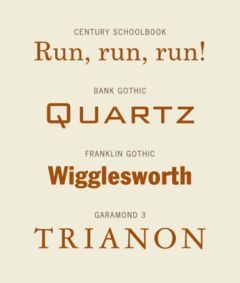Morris Fuller Benton
| Morris Fuller Benton | |
|---|---|
| Born | November 30, 1872 |
| Died | June 30, 1948 (aged 75) |
| Occupation | Type designer, business executive |

Morris Fuller Benton (November 30, 1872 – June 30, 1948) was an influential American typeface designer who headed the design department of the American Type Founders (ATF), for which he was the chief type designer from 1900 to 1937. Benton was America's most prolific type designer, having completed 221 typefaces, ranging from revivals of historical models like ATF Bodoni, to adding new weights to existing faces such as Goudy Old Style and Cheltenham, and to designing original designs such as Hobo, Bank Gothic, and Broadway. Benton's large family of related neogrotesque sans-serif typefaces, known as "gothics" as was the norm at the time, includes Alternate Gothic, Franklin Gothic, and News Gothic. These typefaces better anticipated and were more similar to later realist sans-serif typefaces such as Helvetica than the other early grotesque types of his contemporaries.
Typefaces
Technology
In addition to his strong aesthetic design sense, Morris was a master of the technology of his day. His father, Linn Boyd Benton, invented the pantographic engraving machine, which was capable not only of scaling a single font design pattern to a variety of sizes, but could also condense, extend, and slant the design (mathematically, these are cases of affine transformation, which is the fundamental geometric operation of most systems of digital typography today, including PostScript). Morris worked on many of these machines with his father at ATF, during which these machines were refined to an impressive level of precision.
Theo Rehak, the current owner of most ATF typecasting equipment and author of the definitive treatise "Practical Typecasting", explains that the Bentons demanded that any deviation in machining or casting be within two ten thousandths of an inch.[1] Most modern machine shops are equipped to measure down to a one thousandth inch variance. As an advertising device, in 1922 ATF manufactured a piece of type eight points tall containing the entire Lord's Prayer in 13 lines of text, using a cutting tool roughly equivalent to a 2000 dpi printer.
References
- Baines, Phil, Haslam, Andrew. Type and Typography. Watson-Guptill Publications: 2005. ISBN 0-8230-5528-0.
- Blackwell, Lewis. 20th Century Type. Yale University Press: 2004. ISBN 0-300-10073-6.
- Cost, Patricia. The Bentons: How an American Father and Son Changed the Printing Industry. Cary Graphic Arts Press, 2011. ISBN 978-1-933360-42-3.
- Fiedl, Frederich, Nicholas Ott and Bernard Stein. Typography: An Encyclopedic Survey of Type Design and Techniques Through History. Black Dog & Leventhal: 1998. ISBN 1-57912-023-7.
- Jaspert, W. Pincus, W. Turner Berry and A.F. Johnson. The Encyclopedia of Type Faces. Blandford Press Lts.: 1953, 1983. ISBN 0-7137-1347-X.
- Macmillan, Neil. An A–Z of Type Designers. Yale University Press: 2006. ISBN 0-300-11151-7.
- Meggs, Phillip B. Revival of the Fittest. RC Publications, Inc: 2002. ISBN 1-883915-08-2.
- Rollins, Carl Purlington American Type Designers and Their Work. in Print (magazine), V. 4, #1.
- MacGrew, Mac, "American Metal Typefaces of the Twentieth Century," Oak Knoll Books, New Castle Delaware, 1993, ISBN 0-938768-34-4.
- ↑ Theo Rehak. "Dale Guild Artifacts". Retrieved 2007-11-28.
External links
- Morris Benton blog, related to the 2011 book The Bentons: How an American Father and Son Changed the Printing Industry by Patricia Cost
- Linn Boyd Benton, Morris Fuller Benton, and Typemaking at ATF (PDF)
- Morris Fuller Benton history by Cynthia Jacquette
- Morris Fuller Benton